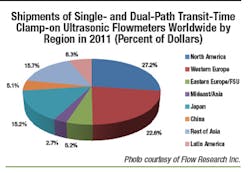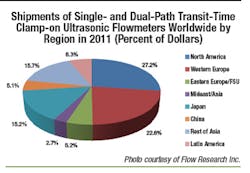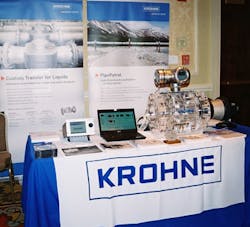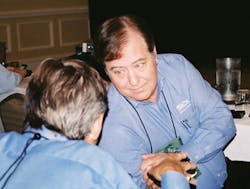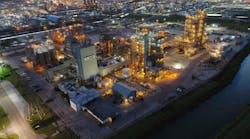It is no secret that at the end of 2008 and through 2009, the United States and much of the world experienced the most severe recession since the 1930s. This recession was so severe that even some new-technology flowmeters, such as Coriolis and magnetic, experienced a downturn. In 2010, however, both the Coriolis and ultrasonic flowmeter segments rebounded strongly, as did the thermal meter market.
Growth Factors for the Ultrasonic Flowmeter Market
Growth factors for the ultrasonic flowmeter market include:
-
Greater Appreciation of the Application Advantages;
-
Acceptance as the Highest Accuracy Gas Technology; and
-
Technology Improvements.
Greater Appreciation of the Application Advantages: Ultrasonic flowmeters have been gaining acceptance over the last 10 years as end-users come to understand and appreciate the technology—although some end-users are just now discovering the advantages and potential of ultrasonic flow measurement.
KROHNE”s Altosonic V12 is a custody-transfer gas flowmeter that has 12 chords. Here is a transparent version of the meter on display at the 2012 CEESI Ultrasonic Flowmeter Workshop to show its inner workings.
(Photo courtesy of Flow Research, Inc.)
Advantages of ultrasonic flowmeters include high accuracy, high reliability, high turndown ratios, long service life, low maintenance, relatively low cost, valuable diagnostics, no moving parts, and redundancy capabilities. Clamp-on ultrasonic flowmeters, in particular, can offer redundancy by providing an easy check of an inline meter.
In addition to the traditional advantages, suppliers are significantly improving accuracy, sensitivity and reliability. Energy, including energy conservation, and other markets have the potential to create even more demand, particularly as the technology improves to enable new applications. As oil prices have increased, ultrasonic has played a more important role in the oil patch and in custody-transfer applications.
Further sweetening the pot is the fact that average ultrasonic prices are holding their own or even declining, which adds to their appeal. In comparison, the average price for Coriolis flowmeters has had upward pressure due to the recent introductions of largeline size models in the 10- to 16-inch diameter range.
The increased use of battery power supplies opens up additional opportunities for ultrasonic flowmeters in the water and irrigation industries, as well as other applications. Battery-powered flowmeters offer low energy consumption independent of the main power grid and can help reduce prices on the worldwide market. Batterypowered applications are also growing for magnetic flowmeters.
Acceptance as the Highest Accuracy Gas Technology: Ultrasonic flowmeters have become accepted as the highest accuracy technology for gas, and acceptance for liquids is following suit. In fact, some users trust ultrasonic flowmeters so much that they employ them with limited or no on-site proving. The acceleration in trust for gas ultrasonic meters began following approvals by the American Gas Association (AGA) for use of ultrasonic flowmeters in custody transfer of natural gas in 1998.
Technology Improvements: Flowmeter manufacturers are focusing a great deal of attention on ultrasonic flowmeters, perhaps at the expense of other meters such as vortex and turbine. Suppliers have made significant progress in enhancing the accuracy and reliability of ultrasonic flowmeters. This has mainly been done by increasing the number of paths, thereby increasing the number of measurement points, and also by adding greater diagnostic capability. The enhanced diagnostic capability, it is claimed, can reduce the need for upstream piping, as well as increase the ability of the ultrasonic meter to determine sources of error. Lately, new and more accurate meters have been developed for custody transfer of petroleum liquids, as well as for custody transfer of natural gas.
Growth Factors for the Coriolis Flowmeter Market
Growth factors for the Coriolis flowmeter market include:
-
Users Are Looking for Low Maintenance;
-
Straight-Tube Meters Address Some Issues with Bent-Tube Meters; and
-
Coriolis Flowmeters for Large Lines.
Users are Looking for Low Maintenance: Coriolis meters have a reputation for being high-priced meters. However, most users today take into account the distinction between purchase cost and cost of ownership, or lifecycle cost. Even though Coriolis meters have a higher purchase cost than many other flowmeters, they may cost less over the lifetime of the meter due to reduced maintenance costs. Unlike turbine and positivedisplacement meters, Coriolis meters do not have any moving parts, apart from the vibrating tube. They are not subject to wear in the way that orifice plates are. With many companies reducing their engineering and maintenance staffs, having a meter that does not require a great deal of maintenance can be a major advantage.
Straight-Tube Meters Address Some Problems with Bent-Tube Meters: While the original Coriolis flowmeters all had bent tubes, straight-tube Coriolis meters have been developed that address some application problems with bent-tube meters. KROHNE introduced the first commercially successful straight-tube Coriolis flowmeter in 1994. Straight-tube meters address the problem of pressure drop because the fluid does not have to travel around a bend. This makes them better able to handle high-velocity fluids. Straight-tube meters can be drained more easily, which is important for sanitary applications. Liquids do not have a bend or curve to build up and leave residue on. Straight-tube meters also have a more compact design. Bent-tube meters can be quite large and unwieldy, especially in the larger sizes. Having a more compact meter can be an advantage where space is a concern. Straight-tube meters are quite popular in the pharmaceutical industry. However, not all pharmaceutical applications are appropriate for straight-tube meters. Most straight-tube meters use titanium, which can leach into certain products. As a result, stainless steel is used for some applications where leaching can occur. In many chemical applications, pressure drop is not an issue, so both straight- and bent-tube meters are used. Straight-tube meters are also widely used in the food processing and chemical industries.
Growth in Coriolis Flowmeters for Large Line Sizes: The expansion in the number of suppliers offering large line size Coriolis flowmeters is one of the major recent headlines in the flowmeter world. Rheonik used to be the only Coriolis flowmeter company to offer meters in line sizes above 6 inches. Then Rheonik was acquired by GE Measurement, and GE Measurement continued to produce the large line-size meters. In the past several years, Endress+Hauser, Micro Motion, and KROHNE have joined the companies offering Coriolis flowmeters in the 8- to 16-inch line-size range. This development is dramatically changing the Coriolis flowmeter market. One factor behind the move to larger line sizes is the need for greater accuracy and reliability in measurement. Coriolis meters are the most accurate meter made, and with no moving parts have high reliability. Another major driving factor is the search for energy, especially in the oil & gas industry. Rising oil prices put a premium on accurate measurement of oil. And even though natural gas prices have remained relatively low, the use of natural gas is increasing as natural gas is seen more and more as a cleaner alternative to oil. Natural gas is also viewed by many as a bridge to renewable, a bridge that may need to last at least 20 to 30 years. Many of the new large line size Coriolis meters are designed for custody-transfer applications in the oil & gas industry.
Intellectual Mindshare
(Photo courtesy of Flow Research, Inc.)
Ultrasonic flowmeters have grabbed much of the intellectual mindshare of the flowmeter world. Ultrasonic is one of few flowmeter technologies that have spawned international conferences devoted to exploring new product developments and applications. In 1999, Steve Caldwell of Colorado Engineering Experiment Station, Inc. (CEESI) began an annual Ultrasonic Meter Workshop (USM). The first Workshop was held in 1999 in Clear Lake, Iowa, and had 30 attendees. In 2012, the 14th annual USM was held in Colorado Springs, Colo., with 213 attendees. The USM has also branched out into Santa Cruz, Bolivia, and Kuala Lumpur, Malaysia. CEESI is also planning to expand the Workshop to a location in Europe in 2013.
A second conference that focuses on ultrasonic flowmeters is the North Sea Flow Workshop. This event was held in Tønsberg, Norway in October 2011 and attracted 330 delegates from 29 countries. The 2012 North Sea Flow Workshop will be held in Scotland October 23-26. The workshop is primarily the work of Christian Michelsen Research AS (CMR, www.cmr.no) and TUV SUD NEL Ltd. NEL is involved in flow testing and maintains the UK’s National Flow Measurement Standards. Both CMR and NEL are “think tanks” that work with suppliers and endusers to solve industry problems. Some of these solutions are presented at the annual conferences.
In addition to focusing on ultrasonic flowmeters, the North Sea Flow Workshop focuses on multiphase flowmeters. While multiphase flowmeters have been around for over 25 years, the interest in them has intensified in recent years due to the expanded search for oil and gas and other forms of energy. They were the product of a perceived need to more efficiently measure the three primary flow elements of wellhead output—oil, gas, and water— at a single measuring point. The idea was to effectively combine one or more existing solution technologies into a single unit that would provide real-time data and, if properly packaged, would have the added benefit of portability. Many multiphase flowmeters use a nuclear source to measure density.
Coriolis flowmeters were also featured at the 2011 North Sea Flow Workshop. The recent development of large line-size Coriolis meters by multiple suppliers has brought Coriolis meters into play in the energy sector. Topics addressed include their suitability for fiscal liquid applications and the ability of Coriolis meters to handle two-phase measurement.
Flowmeter conferences provide more than the ability to present papers and view exhibits. A lot of interaction among the participants goes on at these conferences, and technical problems are discussed by suppliers and end-users alike. This facilitates research and promotes the development of new features and products. This type of networking is not typically going on among positive-displacement, turbine, and variable-area flowmeter suppliers and users. The growing interest in and attendance at ultrasonic, Coriolis, and multiphase conferences helps demonstrate that these technologies are at the intellectual forefront of the flowmeter world.
Nothing Will Change & Yet Everything Will Change
It is difficult to see what can stop the ultrasonic and Coriolis flowmeter markets. These flowmeters have so many advantages not shared by other types of meters that the shift to these meters is bound to continue. The only flowmeter type that can compete in terms of growth is multiphase, but multiphase meters do not compete with ultrasonic and Coriolis meters. In fact, some multiphase meters incorporate Coriolis meters as components. Vortex, thermal, positive-displacement, and turbine meters have their advantages, but they are smaller in scope compared to the advantages of ultrasonic and Coriolis meters. So look for more solid growth in the ultrasonic and Coriolis flowmeter markets, as these meters continue to displace other types.
Jesse Yoder, Ph.D., is president of Flow Research Inc. in Wakefield, Mass., a company he founded in 1998. He has 25 years of experience as an analyst and writer in process control. Dr. Yoder specializes in flowmeters and other field devices, including pressure and temperature products. Dr. Yoder can be reached at [email protected].
